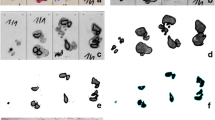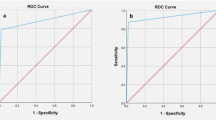Abstract
Objective
We compared two different methods of microscopic lymph node examination of cervical cancer radical hysterectomy specimens to ascertain which method translates into higher nodal counts and improved detection of nodal metastasis, at M. D. Anderson Cancer Center (MDACC) and the University of North Carolina (UNC).
Methods
We retrospectively reviewed the records of 155 patients with early-stage cervical cancer who underwent open radical hysterectomy and pelvic lymph node dissection from 2000 to 2006. At MDACC lymph nodes were grossly dissected from submitted adipose tissue surgical specimens and then microscopically examined. At UNC, grossly detected lymph nodes and the remaining adipose tissue were microscopically examined. Data regarding clinicopathologic features and lymph node dissection were available for all patients.
Results
No differences in stage, grade or histology were noted between the two centers. The median age and body mass index were both higher at MDACC (40 versus 36 years of age; 28 versus 26 mg/m2; P < 0.05) The median lymph node count was lower at MDACC (16 versus 23; P = 0.001). By multivariate analysis, UNC evaluation was associated with higher total lymph node count (P = 0.001). However, no significant difference was noted between institutions in proportion of patients with nodal metastases (MDACC 20.3%; UNC 13.5%; P = 0.47).
Conclusion
The UNC method of microscopically examining the entire adipose tissue sample may be associated with higher nodal count at open radical hysterectomy. Higher nodal count, however, may not translate into increased identification of nodal metastases.
Similar content being viewed by others
References
Jemal A, Siegel R, Ward E, et al. Cancer statistics, 2008. CA Cancer J Clin. 2008;58:71–96.
Sedlis A, Bundy BN, Rotman MZ, Lentz SS, Muderspach LI, Zaino RJ. A randomized trial of pelvic radiation therapy versus no further therapy in selected patients with stage IB carcinoma of the cervix after radical hysterectomy and pelvic lymphadenectomy: A Gynecologic Oncology Group Study. Gynecol Oncol. 1999;73:177–83.
Alvarez RD, Potter ME, Soong SJ, et al. Rationale for using pathologic tumor dimensions and nodal status to subclassify surgically treated stage IB cervical cancer patients. Gynecol Oncol. 1991;43:108–12.
Buckley SL, Tritz DM, Van Le L, et al. Lymph node metastases and prognosis in patients with stage IA2 cervical cancer. Gynecol Oncol. 1996;63:4–9.
Marchiole P, Buenerd A, Benchaib M, Nezhat K, Dargent D, Mathevet P. Clinical significance of lympho vascular space involvement and lymph node micrometastases in early-stage cervical cancer: a retrospective case-control surgico-pathological study. Gynecol Oncol. 2005;97:727–32.
Novakovic P, Mandic A, Vujkov T, et al. Radical hysterectomy for stage IB1 cervical carcinoma: lymph node metastasis as a prognostic factor. J Buon. 2002;7:247–50.
Chou HH, Chang TC, Yen TC, et al. Low value of [18F]-fluoro-2-deoxy-D-glucose positron emission tomography in primary staging of early-stage cervical cancer before radical hysterectomy. J Clin Oncol. 2006;24:123–8.
Rockall AG, Sohaib SA, Harisinghani MG, et al. Diagnostic performance of nanoparticle-enhanced magnetic resonance imaging in the diagnosis of lymph node metastases in patients with endometrial and cervical cancer. J Clin Oncol. 2005;23:2813–21.
Milam MR, Frumovitz M, dos Reis R, Broaddus RR, Bassett RL Jr., Ramirez PT. Preoperative lymph-vascular space invasion is associated with nodal metastases in women with early-stage cervical cancer. Gynecol Oncol. 2007;106:12–5.
Wydra D, Sawicki S, Wojtylak S, Bandurski T, Emerich J. Sentinel node identification in cervical cancer patients undergoing transperitoneal radical hysterectomy: a study of 100 cases. Int J Gynecol Cancer. 2006;16:649–54.
Di Stefano AB, Acquaviva G, Garozzo G, et al. Lymph node mapping and sentinel node detection in patients with cervical carcinoma: a 2-year experience. Gynecol Oncol. 2005;99:671–9.
Ferraris G, Lanza A, D’Addato F, et al. Techniques of pelvic and para-aortic lymphadenectomy in the surgical treatment of cervix carcinoma. Eur J Gynaecol Oncol. 1988;9:83–6.
Abu-Rustum NR, Gemignani ML, Moore K, et al. Total laparoscopic radical hysterectomy with pelvic lymphadenectomy using the argon-beam coagulator: pilot data and comparison to laparotomy. Gynecol Oncol. 2003;91:402–9.
Malur S, Possover M, Michels W, Schneider A. Laparoscopic-assisted vaginal versus abdominal surgery in patients with endometrial cancer—a prospective randomized trial. Gynecol Oncol. 2001;80:239–44.
Boggess JF, Gehrig PA, Cantrell L, et al. A case-control study of robot-assisted type III radical hysterectomy with pelvic lymph node dissection compared with open radical hysterectomy. Am J Obstet Gynecol. 2008;199:357.e1–7.
Malur S, Possover M, Schneider A. Laparoscopically assisted radical vaginal versus radical abdominal hysterectomy type II in patients with cervical cancer. Surg Endosc. 2001;15:289–92.
Frumovitz M, dos Reis R, Sun CC, et al. Comparison of total laparoscopic and abdominal radical hysterectomy for patients with early-stage cervical cancer. Obstet Gynecol. 2007;110:96–102.
Monk BJ, Cha DS, Walker JL, et al. Extent of disease as an indication for pelvic radiation following radical hysterectomy and bilateral pelvic lymph node dissection in the treatment of stage IB and IIA cervical carcinoma. Gynecol Oncol. 1994;54:4–9.
Roman LD, Felix JC, Muderspach LI, et al. Influence of quantity of lymph-vascular space invasion on the risk of nodal metastases in women with early-stage squamous cancer of the cervix. Gynecol Oncol. 1998;68:220–5.
Delgado G, Bundy BN, Fowler WC Jr., et al. A prospective surgical pathological study of stage I squamous carcinoma of the cervix: a Gynecologic Oncology Group Study. Gynecol Oncol. 1989;35:314–20.
Santoso JT, Azadi A, Wan J, Handorf C, Coleman RL, Tillmanns TD. Lymph node counts in uterine cancer: a randomized double blind trial. Gynecol Oncol. 2009;113:159–62.
Brown HG, Luckasevic TM, Medich DS, Celebrezze JP, Jones SM. Efficacy of manual dissection of lymph nodes in colon cancer resections. Mod Pathol. 2004;17:402–6.
Hida J, Mori N, Kubo R, et al. Metastases from carcinoma of the colon and rectum detected in small lymph nodes by the clearing method. J Am Coll Surg. 1994;178:223–8.
Herrera L, Villarreal JR. Incidence of metastases from rectal adenocarcinoma in small lymph nodes detected by a clearing technique. Dis Colon Rectum. 1992;35:783–8.
Candela FC, Urmacher C, Brennan MF. Comparison of the conventional method of lymph node staging with a comprehensive fat-clearing method for gastric adenocarcinoma. Cancer. 1990;66:1828–32.
Brooks SE, Chen TT, Ghosh A, Mullins CD, Gardner JF, Baquet CR. Cervical cancer outcomes analysis: impact of age, race, and comorbid illness on hospitalizations for invasive carcinoma of the cervix. Gynecol Oncol. 2000;79:107–15.
Brun JL, Stoven-Camou D, Trouette R, Lopez M, Chene G, Hocke C. Survival and prognosis of women with invasive cervical cancer according to age. Gynecol Oncol. 2003;91:395–401.
Frumovitz M, Sun CC, Jhingran A, et al. Radical hysterectomy in obese and morbidly obese women with cervical cancer. Obstet Gynecol. 2008;112:899–905.
Munstedt K, Wagner M, Kullmer U, Hackethal A, Franke FE. Influence of body mass index on prognosis in gynecological malignancies. Cancer Causes Control. 2008;19:909–16.
Chung HH, Kang SB, Cho JY, et al. Can preoperative MRI accurately evaluate nodal and parametrial invasion in early stage cervical cancer? Jpn J Clin Oncol. 2007;37:370–5.
Author information
Authors and Affiliations
Corresponding author
Rights and permissions
About this article
Cite this article
Milam, M.R., Abaid, L., Reis, R.d. et al. Microscopic Evaluation of Lymph-Node-Bearing Tissue in Early-Stage Cervical Cancer: A Dual-Institution Review. Ann Surg Oncol 17, 1106–1110 (2010). https://doi.org/10.1245/s10434-009-0870-1
Received:
Published:
Issue Date:
DOI: https://doi.org/10.1245/s10434-009-0870-1




